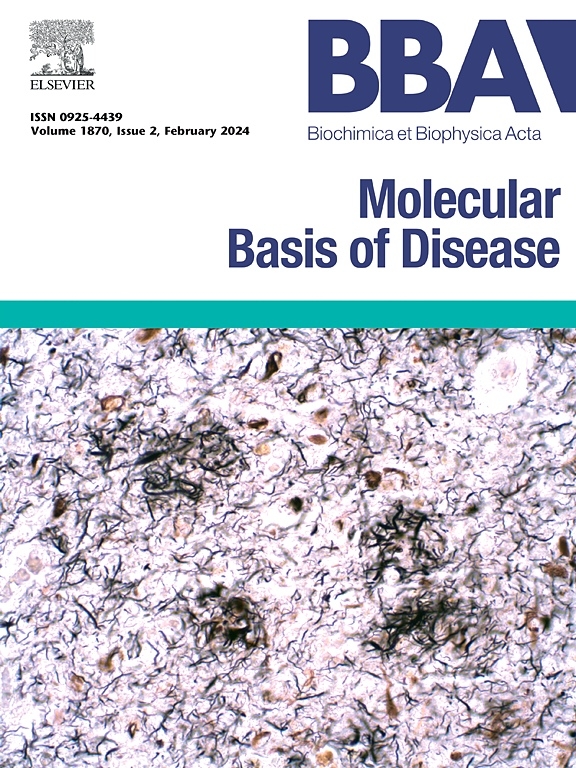胶质瘤细胞通过Wnt/β-catenin信号通路产生可溶性PD-L1,抑制CD8+ T细胞活性
IF 4.2
2区 生物学
Q2 BIOCHEMISTRY & MOLECULAR BIOLOGY
Biochimica et biophysica acta. Molecular basis of disease
Pub Date : 2025-08-08
DOI:10.1016/j.bbadis.2025.168013
引用次数: 0
摘要
可溶性程序性死亡配体1 (sPD-L1)正在成为一种新的预后标志物,有可能取代PD-L1来评估预后和免疫治疗效果。然而,我们对sPD-L1知之甚少。本研究旨在评估sPD-L1作为生物标志物的潜力,并探讨其起源和生物学功能。该研究发现,血浆中sPD-L1浓度与胶质瘤患者较差的总生存率(OS)有关。Ki-67高表达、idh野生型或高级别患者sPD-L1水平较高。值得注意的是,患者和小鼠的sPD-L1浓度与肿瘤体积呈正相关。将不同sPD-L1浓度的小鼠血浆与CD8+ T细胞共培养,观察sPD-L1的活性和功能。我们得出结论,胶质瘤细胞通过Wnt/β-catenin信号通路产生sPD-L1,该信号通路与CD8+ T细胞上的PD-1受体相互作用,通过降低IFN-γ水平抑制其功能。Wnt抑制剂联合PD-L1抑制剂可通过进一步降低sPD-L1水平来增强抗肿瘤作用。本文章由计算机程序翻译,如有差异,请以英文原文为准。

Glioma cells produce soluble PD-L1 via the Wnt/β-catenin signaling pathway to suppress CD8+ T cell activity
Soluble programmed death ligand 1 (sPD-L1) is emerging as a novel prognostic marker, potentially replacing PD-L1 for assessing prognosis and immunotherapy effectiveness. However, little is known about sPD-L1. This study aimed to assess sPD-L1's potential as a biomarker and explore its origin and biological function. The study found sPD-L1 concentration in plasma is linked to worse overall survival (OS) in glioma. Patients with high Ki-67 expression, IDH-wild type or high-grade have higher level of sPD-L1. Notably, sPD-L1 concentration is positive correlations with tumor volume in patients and mice. Mice plasma with varying sPD-L1 concentration was co-cultured with CD8+ T cells to investigate sPD-L1 activity and function. We conclude that glioma cells produce sPD-L1 through the Wnt/β-catenin signaling pathway, which interacts with the PD-1 receptor on CD8+ T cells, inhibiting their function by reducing IFN-γ levels. Wnt inhibitors combined with PD-L1 inhibitors can enhance the anti-tumor effect by further reducing sPD-L1 levels.
求助全文
通过发布文献求助,成功后即可免费获取论文全文。
去求助
来源期刊
CiteScore
12.30
自引率
0.00%
发文量
218
审稿时长
32 days
期刊介绍:
BBA Molecular Basis of Disease addresses the biochemistry and molecular genetics of disease processes and models of human disease. This journal covers aspects of aging, cancer, metabolic-, neurological-, and immunological-based disease. Manuscripts focused on using animal models to elucidate biochemical and mechanistic insight in each of these conditions, are particularly encouraged. Manuscripts should emphasize the underlying mechanisms of disease pathways and provide novel contributions to the understanding and/or treatment of these disorders. Highly descriptive and method development submissions may be declined without full review. The submission of uninvited reviews to BBA - Molecular Basis of Disease is strongly discouraged, and any such uninvited review should be accompanied by a coverletter outlining the compelling reasons why the review should be considered.

 求助内容:
求助内容: 应助结果提醒方式:
应助结果提醒方式:


